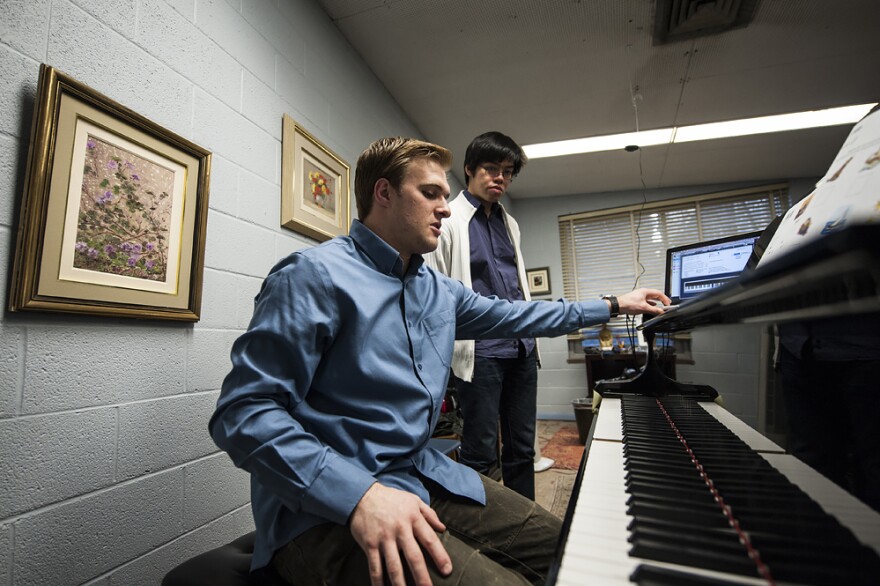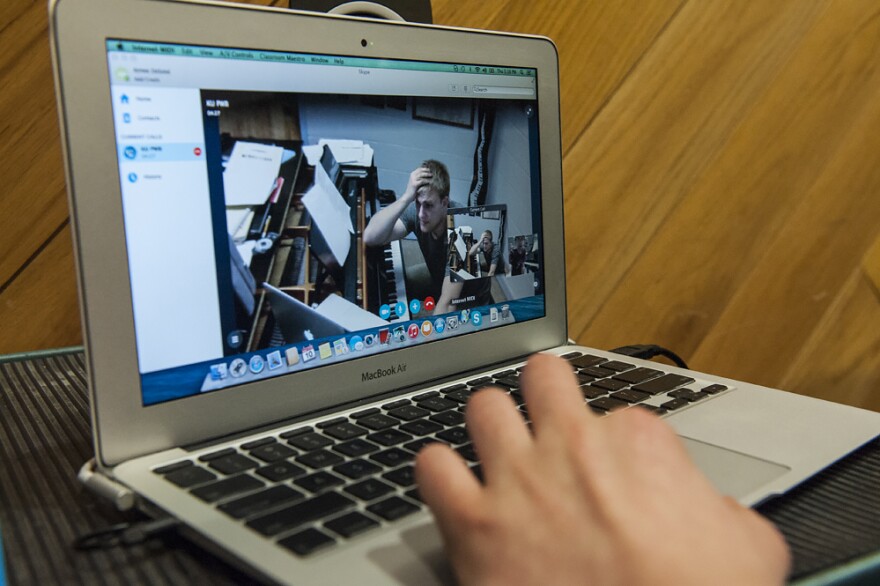Sixth-grader Miguel Gonzales sits at a grand piano at Eisenhower Middle School in Kansas City, Kansas. He’s in a large room reserved for special events.
Under a mop of auburn hair, Gonzales smiles shyly as he waits for his lesson to begin. His instructor Paul Adams (that’s Mr. Adams to Gonzales) soon shows up — on the screen of a laptop. Adams, a graduate student in piano at the University of Kansas, is about 35 miles away in a music studio on the Lawrence campus.
“So I hear you’re on spring break, Miguel,” Adams says as he greet Gonzales. “How’s that going?”
“It’s going great,” Gonzales replies. And, after a little more conversation, Adams begins the lesson where the two left off last week.
Gonzales is one of seven students at Eisenhower in the pilot project called Pianos Without Borders. It’s thought to be one of the first of its kind in the country. The lessons are free and the program pairs middle school students who want to learn with KU students who want to teach.
Last fall, the program got a jump start when the local charity Band of Angels donated a $20,000 Yamaha Disklavier piano to the middle school.
The Disklavier uses MIDI, short for Musical Instrument Digital Interface. This protocol sends signals from one device to another, such as instruments to computers. The MIDI interface has been around since the early 1980s, and it allows different instruments to "speak" with each other. Pianos Without Borders combines MIDI with Skype so teachers and students can communicate directly.

Later, after his lesson with Gonzales, Adams describes the process from his piano bench at KU: “Let me show you when I play soft. Watch the computer screen," he says and plays a note. "So you see there’s only two marks there. When I play loud" — he plays another note — "five little marks. So it sees exactly how fast I play it. It knows how long I play it. Then it sends that signal over the Internet, happens on the student's piano. It’s really, really kinda cool."
Aimee DeSotel is in her tenth year teaching band and orchestra at Eisenhower. Her day-to-day instruction with students is more analog than digital. But DeSotel says she appreciates what these tools bring into the classroom.
“I like it that the students see the teachers face to face through that screen, but that they can also look down at their fingers because it’s also angled down that way,” DeSotel says. “And then the teacher can say, ‘Hang on. Watch your keys.' They can really break it down.”

Adams says he was eager to find students who were equally enthusiastic about learning. He describes Skype and the Disklavier together as a potent mix — especially for those new to piano.
“Ordinarily when I would teach a piano lesson to someone over a long distance, I would use Skype. And the trouble with Skype is that it is made for voice."
That made it hard for students to tell how loudly or softly he was playing, because Skype would automatically adjust, Adams says. It was also hard for students to hear a difference when he tried to tell them when to play chords with pedals.

"If you are teaching someone who is already familiar with piano, it might work OK," he says. "But if you are starting beginners, a system that plays a piano exactly as you are playing it is amazing.”
Gonzales started taking lessons from Adams about six months ago. He says watching and hearing his teacher play the piano helps him work through a piece of music.
“Whenever he presses a key, it gives me a boost to know what I am playing and what I’m doing wrong and what I should do. It just helps me a lot,” says Gonzales.
Pioneering a new technique is never easy. And there were surprising challenges in the early stages. Adams says he never imagined he’d have to become technologically savvy to teach piano.
“It’s a new technology so there are no YouTube tutorials,” he says. “There are no blogs talking about it. The router at the school didn’t like us, so we had to figure out a way to make it happy. Every once in awhile, like anywhere, the Internet goes down so then you’re like, 'Oh, wow.' Suddenly you can’t have a piano lesson.”
But DeSotel says her middle schoolers barely notice the glitches.
“They’ve all really embraced it," she says. “Their generation is so used to technology, so to them this is nothing at all.”
At its core, DeSotel says, teaching is all about the human connection.
“You’ve got to make some type of a connection with the students so they will really buy in and want to please you and work hard," she says. "Miguel is a really special student in that he really does put 100 percent effort into everything. He really thinks highly of Mr. Adams. He lights up about music so it’s really neat.”

Adams says the experience for him has been worthwhile. “At least it gives me a chance to make a difference in some really nice kid's life,” he says. “These are kids who are really sweet and I love being able to help ‘em out.”
Julie Denesha is a freelance photographer and reporter for KCUR 89.3. Follow her @juliedenesha.
Austin Fitts with Kansas Public Radio contributed to this story.


